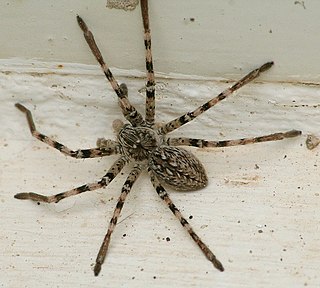
Nursery web spiders (Pisauridae) is a family of araneomorph spiders first described by Eugène Simon in 1890. They resemble wolf spiders (Lycosidae) except for several key differences. Wolf spiders have two very prominent compound eyes in addition to the other six, while a nursery web spider's eyes are all about the same size. Additionally, female nursery web spiders carry their egg sacs with their jaws and pedipalps instead of attaching them to their spinnerets as wolf spiders do. When the eggs are about to hatch, a female spider builds a nursery "tent", places her egg sac inside, and stands guard outside, hence the family's common name. Like the wolf spiders, however, the nursery web spiders are roaming hunters that don't use webs for catching prey.

Idiopidae, also known as armored trapdoor spiders, is a family of mygalomorph spiders first described by Eugène Simon in 1889. They have a large body similar to tarantulas.

Deinopis, also known as net-casting spiders, gladiator spiders and ogre-faced spiders, is a genus of net-casting spiders that was first described by W. S. MacLeay in 1839. Its distribution is widely tropical and subtropical. They catch their prey using a specially spun "net". The name is derived from the Greek δεινός (deinos), meaning "fearful", and opis, meaning "appearance", referring to their ogre-like faces. The spelling "Dinopis" is also found, but is regarded as an "unjustified emendation".

Stegodyphus is a genus of velvet spiders that was first described by Eugène Simon in 1873. They are distributed from Africa to Europe and Asia, with two species found in Brazil. The name is derived from Ancient Greek στέγω (stegos), meaning "covered".

Eusparassus is a genus of huntsman spiders that was first described by Eugène Louis Simon in 1903.
Harpactira is a genus of spider in the family Theraphosidae (tarantulas), found in southern Africa.
Eubrachycercus is a monotypic genus of East African brushed trapdoor spiders containing the single species, Eubrachycercus smithi. It was first described by Reginald Innes Pocock in 1897, and has only been found in Somalia.
Dresserus is a genus of African velvet spiders that was first described by Eugène Simon in 1876.
Gandanameno is a genus of African velvet spiders that was first described by Pekka T. Lehtinen in 1967.
Aethriscus is a genus of Central African orb-weaver spiders first described by Reginald Innes Pocock in 1902. As of April 2019 it contains only two species, both found in Middle Africa.
Pararaneus is a genus of orb-weaver spiders first described by Lodovico di Caporiacco in 1940.

Pasilobus is a genus of orb-weaver spiders first described by Eugène Simon in 1895.
Anchonastus is a genus of African huntsman spiders that was first described by Eugène Louis Simon in 1898.
Panaretella is a genus of South African huntsman spiders that was first described by R. F. Lawrence in 1937.
Parapalystes is a genus of South African huntsman spiders that was first described by P. M. C. Croeser in 1996.
Namaquarachne is a genus of South African araneomorph spiders in the Phyxelididae family, and was first described by C. E. Griswold in 1990.

Chiasmopes is a genus of nursery web spiders that was first described by P. Pavesi in 1883.
Euprosthenops is a genus of nursery web spiders that was first described by Reginald Innes Pocock in 1897.

Nilus is a genus of nursery web spiders that was first described by Octavius Pickard-Cambridge in 1876.
Messapus is a genus of African corinnid sac spiders first described by Eugène Simon in 1898.









